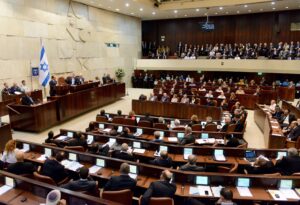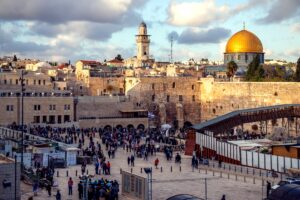Learn ABOUT
Israel
While the State of Israel is less than a century old, the Jewish community has roots in the Holy Land going back at least 3000 years.
 While the State of Israel is less than a century old, the Jewish community has roots in the Holy Land going back at least 3000 years. Ever since the Romans exiled the Jews from Jerusalem in AD 135, the hope of returning to Zion has been a part of the Jewish faith tradition. During the middle ages, Jews slowly returned to Palestine forming a small community. During the 19th century as European anti-Semitism grew, Jewish intellectuals, such as Theodor Herzl, transformed this religious ideal into nationalist aspirations aimed at establishing a Jewish state in Palestine. The British endorsed the Zionist movement in the 1917 Balfour Declaration, though they also recognized the civil and religious rights of the local population. During the interwar period, the British governed Palestine and helped facilitate Jewish immigration during the 1920s. However, tensions began to escalate between Jewish immigrants and local Palestinians. As a result of the escalating violence, the United Nations stepped in to partition the land into separate Jewish and Arab states.
While the State of Israel is less than a century old, the Jewish community has roots in the Holy Land going back at least 3000 years. Ever since the Romans exiled the Jews from Jerusalem in AD 135, the hope of returning to Zion has been a part of the Jewish faith tradition. During the middle ages, Jews slowly returned to Palestine forming a small community. During the 19th century as European anti-Semitism grew, Jewish intellectuals, such as Theodor Herzl, transformed this religious ideal into nationalist aspirations aimed at establishing a Jewish state in Palestine. The British endorsed the Zionist movement in the 1917 Balfour Declaration, though they also recognized the civil and religious rights of the local population. During the interwar period, the British governed Palestine and helped facilitate Jewish immigration during the 1920s. However, tensions began to escalate between Jewish immigrants and local Palestinians. As a result of the escalating violence, the United Nations stepped in to partition the land into separate Jewish and Arab states.
 As of 2017, Israel has a population of 8.8 million, bolstered by Jewish immigration from the Middle East, Europe, the United States, and former Soviet Union over the last fifty years. Israeli society continues to be both ethnically and religiously diverse. About 20 percent of Israeli citizens are Arabic-speaking Muslims and Christians. The Israeli Jewish community encompasses European Jews, Oriental Jews, and Ethiopian Jews spanning a spectrum of religiosity from secular to Ultra-orthodox. The Nation State Basic Law defining Israel as an explicitly Jewish state poses challenges to cultural and religious pluralism in Israel. Additionally, Israel faces national security challenges stemming from its occupation of the West Bank, Gaza Strip, and Golan Heights. Churches for Middle East Peace (CMEP) holds that ending the occupation through a comprehensive negotiated settlement is the best way to achieve long term security for Israel and the Jewish people (see CMEP policy positions).
As of 2017, Israel has a population of 8.8 million, bolstered by Jewish immigration from the Middle East, Europe, the United States, and former Soviet Union over the last fifty years. Israeli society continues to be both ethnically and religiously diverse. About 20 percent of Israeli citizens are Arabic-speaking Muslims and Christians. The Israeli Jewish community encompasses European Jews, Oriental Jews, and Ethiopian Jews spanning a spectrum of religiosity from secular to Ultra-orthodox. The Nation State Basic Law defining Israel as an explicitly Jewish state poses challenges to cultural and religious pluralism in Israel. Additionally, Israel faces national security challenges stemming from its occupation of the West Bank, Gaza Strip, and Golan Heights. Churches for Middle East Peace (CMEP) holds that ending the occupation through a comprehensive negotiated settlement is the best way to achieve long term security for Israel and the Jewish people (see CMEP policy positions).

(Sources: CIA World Factbook, 2017 and Israeli Central Bureau of Statistics, 2018)
Population: 8,842,000
Religions: Judaism: 74.7%, Islam: 17.7%, Christianity: 2%, Druze: 1.6%, Other: 4%
Religiosity among Jewish Israelis: 44% Secular, 22% Non-observant Traditional, 13% Observant Traditional, 11% National Religious, 10% Haredi (Ultra-Orthodox)
Religiosity among Palestinian Israelis: 21% Not Religious, 22% Somewhat Religious, 53% Religious, 4% Very Religious
Ethnicities: Jewish: 6.993 million (79%), Palestinian Arab: 1.849 (21%)
Immigrants since 1949: 3.2 million
Victims of Palestinian Violence and Terrorism since September 2000
Range of Fire from Lebanon
Range of Fire from Gaza
 Reports
Reports Israel and the Occupied Territories 2016 Human Rights Report [U.S. Department of State]
“The most significant human rights problems were terrorist attacks targeting civilians and politically and religiously motivated societal violence; institutional and societal discrimination against Arab citizens of Israel, many of whom self-identify as Palestinian…Other human rights problems included administrative detention, often extraterritorial in Israel, of Palestinians from the occupied territories; stigmatizing of human rights nongovernmental organizations (NGOs); the treatment of asylum seekers and irregular migrants; institutional and societal discrimination against non-Orthodox Jews and intermarried families; and labor rights abuses against Arab and foreign workers.” Read More
Inequality Report [Adaleh, March 2011]
Inequality in Israel takes many forms. Some of the major fault-lines that
divide Israeli society, creating relatively privileged and deprived groups, are
(Ashkenazim) versus (Mizrahim); men versus women; Israel-born Jews (Sabar)
versus new immigrants (Olim); Orthodox versus secular Jews; rural versus
urban dwellers; rich versus poor; left-wing versus right-wing supporters; and
gay versus straight people. This report focuses on inequalities between Jewish
citizens of Israel—the majority—and Palestinian Arab citizens of Israel, a
national, non-immigrant minority living in its historical homeland. Read More
110 Maryland Ave NE #505
Washington, DC 20002